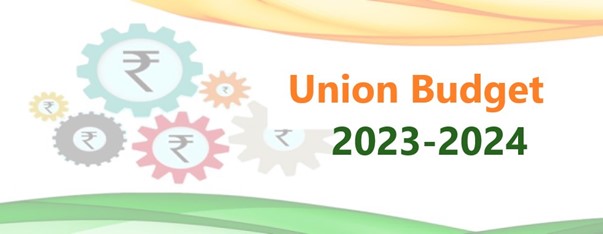Union Budget 2023
Kruthika Jerome, March 30, 2023

Green growth has been highlighted as one of the four transformative opportunities in “the first budget of Amrit Kaal”, envisioned to shape the country’s future leading up to its 100th year of independence in 2047. Amid strong growth projections at 7% GDP growth, the government has increased capital investment outlay by 33% to INR 10 lakh crores. The budget is indicative of an expansionary public expenditure policy, while keeping a strict eye on the fiscal deficit. Green economy will decidedly play a role in India’s future development, albeit on a cautious runway.
Decarbonisation of transport and industry sector along with promotion of non-fossil fuel based energy generation was emphasised through budgetary outlays for critical technology development. Reiterating an outlay of INR 19,700 crores for the green hydrogen mission, the Finance Minister also announced support through viability gap funding for the set-up of battery energy storage systems (BESS) facility with a capacity of 4,000 MWH. The announcement will be followed by formulation of a detailed framework for pumped storage projects. Coastal shipping for both, passengers and freight, will be promoted as an energy-efficient mode of transport through Public-Private-Partnership (PPP) mode with viability gap funding. Additionally, the concessional duty on lithium-ion cells for batteries was extended for another year, with customs duty exemption extended on capital goods and machinery required for the production of lithium-ion batteries in the automotive sector.
Incentivisation of battery and energy storage systems development is a welcome move, given its pertinence towards stabilisation of renewable power variability along with electric mobility objectives. Complementing these efforts, the budget also announced the creation of an interstate transmission system for evacuation and grid integration of 13 GW renewable energy from Ladakh, with an initial investment of INR 20,700 crore. INR 8,300 crore of this investment outlay will be provided by the Centre. The budget also provides INR 35,000 crore for priority capital investments towards net zero transition and energy security to the ministry of petroleum and natural gas.
The centre’s nudge towards green farming, waste-to-value and conservation efforts is equally worth noting. The Atmanirbhar clean plant program will promote high-quality horticulture at an outlay of INR 20,200 crores, wherein set-up of 10,000 Bio-input resource centres is planned over the course of three years to facilitate one crore farmers to adopt natural farming. The government also plans to establish a decentralised storage facility network, allowing for increased value creation, reduction in food wastage and associated emissions, while PM PRANAM seeks to incentivise promotion of alternative fertilizers.
Circular economy efforts were emphasized through the GOBARdhan scheme, under which 500 new ‘waste to wealth’ plants will be launched, including 200 compressed biogas plants. At a total investment of INR 10,000 crore and fiscal support for bio-manure collection, waste management has received a clear nod from the centre. Restoration efforts are further joined by MISHTI and Amrit Darohar scheme. MISHTI focuses on mangrove plantation along the coastline and on salt pans, through interesting convergence between MGNREGS and CAMPA (Compensatory Afforestation) funds. Although, it is unclear whether integration with skilling programmes is envisioned under the scheme. Similarly, Amrit Darohar looks at wetlands conservation over next 3 years to encourage optimal use of wetlands and enhance biodiversity. MISHTI and Amrit Dharovar tie a direct line to LiFE mission, where incentivisation of behaviour change will likely be operationalised by a green credit program, to be notified under the Environment (Protection) Act.
While the announcement of several measures to promote green growth has been widely appreciated, there are also some concerns that would need to be addressed. The allocated capital, although welcome, is not adequate against the funding required to drive local technology development and deployment at scale. This indicates a need to improve the leveraging power of public capital through design of effective policy and incentives. Clarity on implementation details of various announced schemes will be a pre-requisite for attracting private investment. Focus on adaptation is low in the budgetary announcements, especially when it comes to building climate-resilient infrastructure, water security and adaptative capacity of communities.
Infrastructure has received a huge push in this year’s budget, with intended setup of Urban Infrastructure Development Fund along with the Infrastructure secretariat and a budgetary outlay of INR 75,000 crores. Among the identified 100 critical infrastructure projects, climate resilience plans are ambiguous. Water security remains a crucial concern. The budgetary scope largely covers access to drinking water and sanitation through the Jal Jeevan Mission; however, there is a need for more focus towards an integrated water management approach. Indirect nudges in agriculture sector have been indicated through promotion of millets in the ‘International year of millets’, that can potentially impact water consumption and cropping patterns. While these are good measures, we may need to do more in the light of increasing frequency of heat waves in the country.
Despite some lingering concerns, the budgetary announcements have been a welcome respite for climate change efforts in a growing country like India. The budget focused on a large spectrum of green growth activities – from technology development, green manufacturing to circular economy and conservation. It will undoubtably act as a stepping stone to usher in the new age of green amrit kaal.

